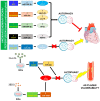Long Noncoding Competing Endogenous RNA Networks in Age-Associated Cardiovascular Diseases
- PMID: 31238513
- PMCID: PMC6627372
- DOI: 10.3390/ijms20123079
Long Noncoding Competing Endogenous RNA Networks in Age-Associated Cardiovascular Diseases
Abstract
Cardiovascular diseases (CVDs) are the most serious health problem in the world, displaying high rates of morbidity and mortality. One of the main risk factors for CVDs is age. Indeed, several mechanisms are at play during aging, determining the functional decline of the cardiovascular system. Aging cells and tissues are characterized by diminished autophagy, causing the accumulation of damaged proteins and mitochondria, as well as by increased levels of oxidative stress, apoptosis, senescence and inflammation. These processes can induce a rapid deterioration of cellular quality-control systems. However, the molecular mechanisms of age-associated CVDs are only partially known, hampering the development of novel therapeutic strategies. Evidence has emerged indicating that noncoding RNAs (ncRNAs), such as long ncRNAs (lncRNAs) and micro RNAs (miRNAs), are implicated in most patho-physiological mechanisms. Specifically, lncRNAs can bind miRNAs and act as competing endogenous-RNAs (ceRNAs), therefore modulating the levels of the mRNAs targeted by the sponged miRNA. These complex lncRNA/miRNA/mRNA networks, by regulating autophagy, apoptosis, necrosis, senescence and inflammation, play a crucial role in the development of age-dependent CVDs. In this review, the emerging knowledge on lncRNA/miRNA/mRNA networks will be summarized and the way in which they influence age-related CVDs development will be discussed.
Keywords: aging; cardiovascular disease; competing endogenous RNA; long noncoding RNA; microRNA.
Conflict of interest statement
The authors declare no conflict of interest. The funders had no role in the design, execution, interpretation, or writing of the study.
Figures






Similar articles
-
Long noncoding RNA/circular noncoding RNA-miRNA-mRNA axes in cardiovascular diseases.Life Sci. 2019 Sep 15;233:116440. doi: 10.1016/j.lfs.2019.04.066. Epub 2019 Apr 30. Life Sci. 2019. PMID: 31047893 Review.
-
Noncoding RNAs in Cardiovascular Aging.Adv Exp Med Biol. 2018;1086:37-53. doi: 10.1007/978-981-13-1117-8_3. Adv Exp Med Biol. 2018. PMID: 30232751 Review.
-
The novel regulatory role of lncRNA-miRNA-mRNA axis in cardiovascular diseases.J Cell Mol Med. 2018 Dec;22(12):5768-5775. doi: 10.1111/jcmm.13866. Epub 2018 Sep 6. J Cell Mol Med. 2018. PMID: 30188595 Free PMC article. Review.
-
Interaction network of coexpressed mRNA, miRNA, and lncRNA activated by TGF‑β1 regulates EMT in human pulmonary epithelial cell.Mol Med Rep. 2017 Dec;16(6):8045-8054. doi: 10.3892/mmr.2017.7653. Epub 2017 Sep 28. Mol Med Rep. 2017. PMID: 28983614 Free PMC article.
-
Uncovering novel landscape of cardiovascular diseases and therapeutic targets for cardioprotection via long noncoding RNA-miRNA-mRNA axes.Epigenomics. 2018 May;10(5):661-671. doi: 10.2217/epi-2017-0176. Epub 2018 Apr 25. Epigenomics. 2018. PMID: 29692219 Review.
Cited by
-
The Complex Interplay of Inflammation, Metabolism, Epigenetics, and Sex in Calcific Disease of the Aortic Valve.Front Cardiovasc Med. 2022 Jan 6;8:791646. doi: 10.3389/fcvm.2021.791646. eCollection 2021. Front Cardiovasc Med. 2022. PMID: 35071359 Free PMC article. Review.
-
Regulatory RNAs in immunosenescence.Immun Inflamm Dis. 2024 Mar;12(3):e1209. doi: 10.1002/iid3.1209. Immun Inflamm Dis. 2024. PMID: 38456619 Free PMC article. Review.
-
LINC01089 Inhibits Tumorigenesis and Epithelial-Mesenchymal Transition of Non-small Cell Lung Cancer via the miR-27a/SFRP1/Wnt/β-catenin Axis.Front Oncol. 2020 Nov 17;10:532581. doi: 10.3389/fonc.2020.532581. eCollection 2020. Front Oncol. 2020. PMID: 33282723 Free PMC article.
-
Identification of prognostic biomarkers and drug target prediction for colon cancer according to a competitive endogenous RNA network.Mol Med Rep. 2020 Aug;22(2):620-632. doi: 10.3892/mmr.2020.11171. Epub 2020 May 22. Mol Med Rep. 2020. PMID: 32468035 Free PMC article.
-
Regulatory Mechanisms of Mitochondrial Function and Cardiac Aging.Int J Mol Sci. 2020 Feb 18;21(4):1359. doi: 10.3390/ijms21041359. Int J Mol Sci. 2020. PMID: 32085438 Free PMC article. Review.
References
-
- World Health Organization (WHO) Cardiovascular Diseases (CVDs) Fact Sheet. WHO; Geneva, Switzerland: 2018.
-
- Heidenreich P.A., Albert N.M., Allen L.A., Bluemke D.A., Butler J., Fonarow G.C., Ikonomidis J.S., Khavjou O., Konstam M.A., Maddox T.M., et al. Forecasting the Impact of Heart Failure in the United States: A Policy Statement from the American Heart Association. Circ. Heart Fail. 2013;6:606–619. doi: 10.1161/HHF.0b013e318291329a. - DOI - PMC - PubMed
Publication types
MeSH terms
Substances
Grants and funding
LinkOut - more resources
Full Text Sources
Medical

